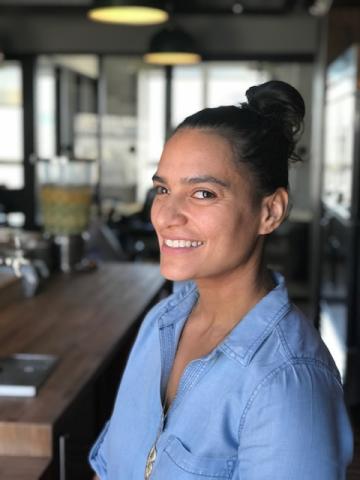
Alumna Bre Gentile, PhD, Brings UX to Non-profit Work

Dr. Bre Gentile spends her day as the Senior Product Researcher & Designer at Safe & Sound, a nonprofit that works “to prevent child abuse and reduce its devastating impact.” In this unique role, she focuses on UX (user experience) in the programs and materials Safe & Sound creates to screen, treat, and prevent toxic stress in children.
UX is a common phrase in the tech world. When done well, it makes websites easier to navigate or it even makes a website user more likely to purchase a product. But Dr. Gentile is working on UX in both the tech- and real-world, to educate, engage and advocate for change. Good UX, she says, can make apps more effective for users, it can make participants more likely to engage in a program.
Dr. Gentile takes it deeper and brings a trauma-informed perspective to her work. “Trauma-informed design is still being defined and standardized by a handful of brave and brazen designers, social workers, psychologists in tech, etc., such as the Greater Good Studio or Rachael Diketus. To me, it means you've either lived or simulated the lives of your end users, you have a deep understanding of them because you've developed a deeper connection over a longer period, and you collaborate with them.” An example could be engaging program participants in evaluating an app, as well as using their experience, firsthand perspective, and writing skills to write the FAQ for the app.
“Restorative design” is another phrase Dr. Gentile uses in her work, describing it as “essential when you have a rupture to repair.”
“Restorative design, at its core, is designing for forgiveness and another shot,” Dr. Gentile said. “How do you do this? Again, it's similar to the components of using trauma-informed design: you acknowledge the lived rupture throughout the entire process, you have a deep understanding of the community that was around during the rupture and the community now by hosting facilitated listening sessions, developing a friendship with both communities, and you include them in any part of the process they are willing and able to be part of. The focus here is really on restoring the wrongs of the organization/company or even of the industry.”
Dr. Gentile joined Center for Youth Wellness, now a program of Safe & Sound, in May 2019. It was a time of transition for the organization and an opportunity to practice restorative design.
“I joined Center for Youth Wellness during a time of change,” Dr. Gentile said. “The founder, Dr. Nadine Burke-Harris, just left to become California's First Surgeon General. It was so exciting for Center for Youth Wellness, and it was a time of change. We used restorative design to propose our next idea. We created a sample brochure of what our idea was about and got insights from the community members which were there when the center first opened as well as new members. One of our guiding principles on this work was to make sure the community approved every step of the way because we didn’t want to overburden the community nor make promises we couldn’t sustainably keep.”
Dr. Gentile, an alumna of both the MS and PhD in Clinical Psychology programs at PAU advises therapists, program managers, tech entrepreneurs, and PAU alumni on how to incorporate restorative design into their work:
“I would say ask yourself these questions:
- What rupture am I repairing (e.g., a broken justice system, broken promises)?
- How do I plan to repair this? Define this qualitatively and quantitatively (e.g., hold three paid listening sessions to be equitable).
- Was the rupture repaired? In gratitude for the opportunity to repair the rupture, be curious if it's repaired by going back to the users immediately, a few weeks after, a month after....Keep in mind: you're friends now, so you need to check in to make sure you're still living up to the repair.”